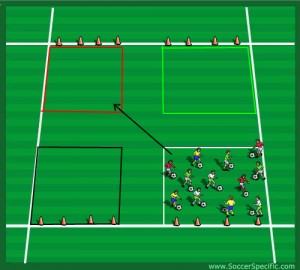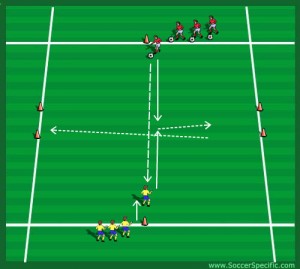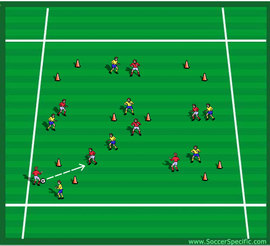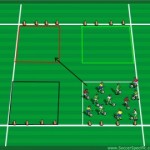U12 Football Coaching Drill
Below is another coaching drill that you can use for your training sessions. You can purchase any coaching gear required from our online store.
U12 Coaching Drill
I took a session for a local U12 side last week. I always prefer my sessions to run smoothly so players aren’t standing about but also that each session is based around the same theme. Last Thursday was an awful night. Strong winds and rain so essential that the players were kept busy and always moving. Likewise, having your coaching area set up so players can move from one thing to the next without you having to have them stand about and take time to re-set your coaching area. I like to see all players with a ball during the warm up dribbling, performing skills and juggling the ball.
My warm up started with all players in a 10 x 10 yard grid with a ball. I made a further 4 different coloured 10 x 10 grids in either corner. This concept is taken from my great Dutch friend, Bert-Jan Heijmans. All players remained in the centre grid dribbling the ball, perfoming skills & juggling the ball. I then performed the ‘Ronaldo 7′ which is 7 different skills performed while the ball is stationary. The idea is that your feet is furthest away from your brain so through repetition will lead to improvement on speed, reaction and the idea of performing skills on the pitch ‘without thinking about it’ or if you prefer, instinct.
I then worked on a spatial awareness game. I had 16 players in the centre zone so I wanted them to react on my whistle and dribble at speed to either of the 4 outside grids. If done correctly we would have 4 players in each grid. The players had great success from this. You can also operate a number of ‘mini games’ within each grid like ’3 v 1′ or ‘Ball Hunter’.
My diagram below doesn’t exactly show what I have explained as it is another variation on my session. If you add another grid in the middle and obviously base on the idea that the players will be split equally amongst the grids.



Dribbling Grid Game

Emphasis
Dribbling, spatial awareness & listening skills game.Set-Up
Great game if you are on your own as a coach or waiting for another group to finish before your allocated time meaning no set up time or little preparation. Start the session inside a 10 x 10 yard grid using all the same colour of cones (although in my diagram you can’t see this the grid should appear in the middle with the other 4 grids on the outside.) All players have a ball & dribble around. While the players are doing that set up another 10 x 10 yard grid alongside it, but leaving a 10 yard safety area. This time use a different colour of cones. Encourage players to look for space & perform skills. Again leave another 10 yard safety area & set up a third 10 x 10 yard area using another colour but keeping inside a ‘square’ shape. Finally set up a forth 10 x 10 yard area using a forth different colour of cones.Objectives
With four different coloured 10 x 10 yard areas set up on the outside players should dribble within the centre grid. On the coaches call players should dribble at speed to the outside grids. I worked with 16 players so ideally there should be 4 players in each grid (unlike my diagram!) On the next call players return to the centre grid. This is an excellent session for players to improve their decision making & getting their head up. Progressions- Play mini games when players are in the outside grids like ’3 v 1′ & ‘Ball Hunter’.
Coaching
- Dribbling skills.
- Tricks.
- Head up.
- Look for space.
- Change of direction / speed.
- Awareness.
- Listening skills.
PSV 1 V 1

Emphasis
1 v 1 duel, beat the defender with a move at speed. This is a simple session that I viewed at the PSV training ground. The Academy played this at a high tempo. Don’t have long lines although work in groups of 4-5 players per grid so each player receives a recovery period.Set-Up
Set up 10 x 10 yard grids with a safety area between each one. Players should position themselves at the top of the grid in the centre facing the defender at the bottom of the grid. Mini Goals should be placed on either side of the grid.Objectives
Defender starts with the ball (red player). They make a firm pass to the attacker (yellow player). The attacker should meet the ball & both players come to the middle of the grid. The attacker performs a skill & attacks one of the goals while the defender applies pressure. Encourage the attacker to be brave, perform a skill & play at speed. They should also be patient & if they cannot score in one goal look to switch & attack the other goal.Progressions
- Increase / decrease area depending on age & group ability.
- Change roles so each player has an opportunity of being a defender & an attacker.
- If defender wins ball they can attack either goal.
Coaching
For attackers;- Accurate driven pass.
- Good close ball control.
- Assertiv, determined dribbling in tight space.
- Use of both feet.
- Change of direction.
- Skills & turns.
- Fakes.
- Be direct.
- Speed.
- Be brave.
- Deny time & space for opponents.
- Pressure first touch.
- Close down space quickly.
- Jockey opponents.
- Force player wide – away from gate.
- Tackle opponent correctly – not from behind, make contact with ball & ensure correct timing.
- Don’t go to ground unless the ball is played out of play.
- Showing a player inside – outside.
5 Goal Game

Emphasis
Possession & combination game focusing on changing the point of attack.Set-Up
2 equal teams play on half a pitch. 5 mini goals / gates are set up within the area using poles or dome cones. You can adapt the size of the area & the amount of mini goals set up to suit your group.Objectives
Teams combine to score a point through dribbling through the gates, passing through the gates or score a bonus point by playing a 1-2 / give-&-go through the gates. Players are not allowed to score back-to-back goals in the same gate.Progressions
- Add more mini goals / gates.
- Colour code certain gates, i.e. gates on the wing to encourage good width.
Coaching
- Good first touch.
- Quality passing.
- Movement & work rate on / off ball.
- Don’t force it through gate, look to open up & switch.
- Always receive ball side on.
- Awareness.
- Communication.

